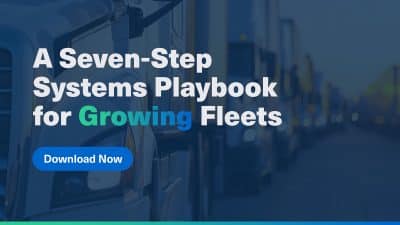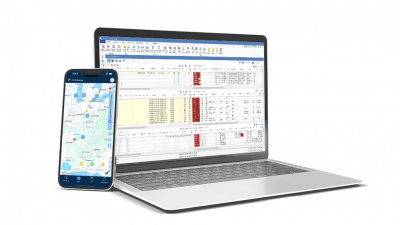It can be tough when you know the benefit of an action, but the thought of starting it is overwhelming. That’s a common occurrence when considering implementing a Transport Management System (TMS).
A TMS offers many benefits — and implementation isn’t difficult if you know what steps to follow. This TMS implementation guide explains the step-by-step process for getting your new TMS up and running.
7 Steps for TMS Implementation
Much of the process for implementing a TMS occurs before installing the software. Any new software deployment requires preparation and strategy, as we’ll explain below.
1. Define Your Strategy
The first step in your TMS implementation is to define your strategy. This process should begin weeks to months before implementation to allow time for gathering input from IT teams, stakeholders, and the people who will use the new TMS every day.
Some key questions to ask are:
- Why do we need a TMS?
- What pain points will it solve?
- Whose input do I need to move forward in this process?
Working on a strategy will help you understand which TMS is right for you.
2. Choose Your TMS
Here are some capabilities to consider when choosing a TMS:
- Carrier and Broker Management: Features like carrier dispatch, accounting, and fleet management help manage relationships and operations with drivers, carriers, and brokers.
- Shipper Operations Enhancement: For shippers, capabilities such as route optimization, dock and yard management, and freight audit and payment systems are vital. These features ensure efficient inbound and outbound freight management, optimize shipping routes and automate transportation-related financial operations.
- Reporting and Analytics: Access to reporting tools and analytics is essential for monitoring performance. It also helps with making data-driven decisions to improve efficiency and reduce costs.
- Integration and Mobility: A TMS should seamlessly integrate into the existing technology stack, including ELDs, Onboarding, Fuel Cards, and EDI systems. It should also provide mobile solutions for on-the-go management and real-time updates.
- Cloud-Based Platform: Opt for a cloud-based TMS for rapid implementation, swift updates, and enhanced security. A cloud-based system also offers the flexibility to scale as the business grows.
The main benefits of using a TMS include:
- Streamlined transportation processes
- Time and cost savings
- Automation of routine tasks
- Optimization of routes
- Real-time visibility into transportation operations
When choosing a TMS, one key consideration is ensuring its features align with your business needs. You also want to consider how it will integrate with your current technology, which you can do by requesting a demo and asking relevant questions.
3. Create an Action Plan
You should create an action plan to ensure your TMS implementation goes smoothly. Begin by choosing a project manager to lead the TMS implementation. This person will run the project, organize tasks to fit the plan, and delegate responsibilities as needed. You could also create a committee of people from key departments to brainstorm about any challenges that might arise.
You should hold regular meetings with stakeholders to ensure tasks are being completed according to deadlines, keep everyone up to date with the TMS implementation, and address any feedback or concerns people may have.
4. Schedule IT Implementation
Your IT department will be involved in implementing a TMS. They will help with any integrations with existing technologies and liaise with the TMS vendor’s support team to configure settings and import needed business data.
Some integrations that you may need to consider are:
- WEX Services for financial transactions
- Samsara for real-time tracking of on-the-road assets
- PC-Miler for accurate routing and mileage calculations
These integrations are vital for your business’s financial, operational, and logistical aspects. The success of this phase depends on the planning and coordination between your IT team and your selected vendor.
5. Test and Evaluate
Once your TMS setup is complete, you should conduct tests with vendor guidance to spot any issues and ensure that the TMS meets your expectations. You should also make sure you conduct testing on mobile devices, as accessing the system remotely helps with operational flexibility.
This stage also focuses on preparing for user adoption through training. Your vendor should provide clear documentation and training materials to ensure your company has champions who understand how the TMS works and can help others.
During testing, you want to capture any user feedback before you fully go live so you can ensure all future users will be well-equipped to use the TMS.
6. Train and Deploy
When launching your TMS, you should adopt a phased approach through pilots to gain greater control over its performance and reduce the impact if something goes wrong. These small launches let you adjust before you push the TMS live to the entire company.
This is also the time to train the TMS users (such as drivers, finance, operations, and third parties) so you can help adopt the new TMS. Most modern TMS platforms offer self-serve training courses to familiarize users with the system. This approach to deployment and training ensures a smoother transition to the new system and can help reduce disruptions.
7. Launch and Monitor
After all the work is done, it’s time to monitor how the TMS performs and how effectively users adopt the platform. This period will help you identify any needs for additional training.
Your IT team should be prepared to respond to a higher volume of support requests after the initial launch, and some of those requests may need to be routed to the TMS vendor. But support requests tend to decrease significantly as users learn their way around new software.
Get Started With TMS Implementation
Distilling the entire TMS implementation into a step-by-step process can make this intimidating task easier to understand and manage.
With so many options on the market, it can be a challenge to pick the right TMS. Ideally, you want a TMS that provides an all-in-one solution like PCS. Features like accounting, safety and compliance management, and carrier dispatch make PCS the best choice for a feature-rich TMS. Book a demo to see how PCS can help you run your business now.



